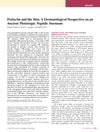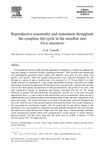 28 citations
,
July 2022 in “Endocrine”
28 citations
,
July 2022 in “Endocrine” Low prolactin in young women may increase heart and metabolism risks.
 98 citations
,
December 2008 in “Journal of Investigative Dermatology”
98 citations
,
December 2008 in “Journal of Investigative Dermatology” Prolactin affects hair growth and skin conditions, and could be a target for new skin disease treatments.
 90 citations
,
October 1998 in “Animal Reproduction Science”
90 citations
,
October 1998 in “Animal Reproduction Science” Mouflon rams mature gradually with changes in body, horns, and hormones linked to age and seasons, reaching full sexual maturity well after puberty.
 9 citations
,
November 2018 in “International Journal of Medical Reviews”
9 citations
,
November 2018 in “International Journal of Medical Reviews” Young men's sexual dysfunction often has physical causes, which can lead to stress and worsen the problem.
18 citations
,
November 1998 in “Comparative biochemistry and physiology. Part A, Molecular & integrative physiology” Changes in prolactin and DHEA levels are not required for the start of mink hair growth cycles.




